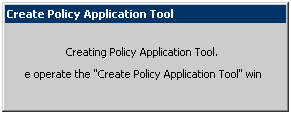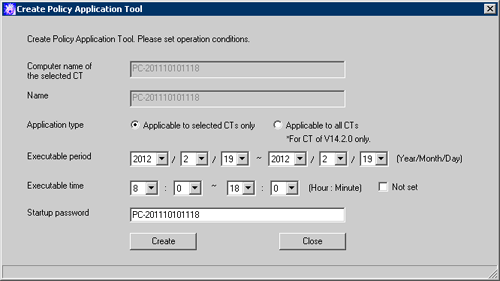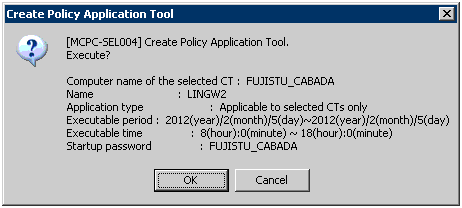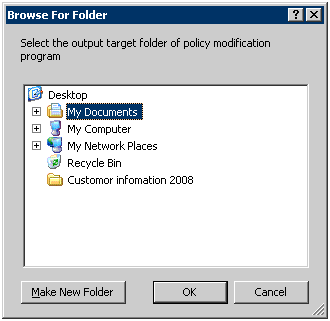Modify CT Policy
The CT policy of the client (CT) that belongs to the “Deleted CT” group cannot be changed. The name and notes cannot be modified as well.
The following describes the procedure of modifying CT policy:
Start [Management Console].
Select the CT group to which the CT that requires modification of policy belongs from the CT group tree.
→The latest policy information is displayed.

Note
In following cases, please update the information of CT group and CT list
When any of the following conditions is satisfied, the information of the CT group or CT list of the Management Server under the Master Management Server displayed in the window may not be updated.
When the CT group tree is modified at Management Server side
When Active Directory Linkage is performed and the group tree is modified
Please select [Refresh Tree] from the [Tree Settings] menu to update.
Select the CT that requires change of policy from the CT list.
Modify policy in each tab of the policy list.
For description of policy setting items, please refer to “2.4.1 Perform Terminal Initial Settings”.
Modify the [Name] or [Notes] displayed in the CT list as needed.
Characters that can be entered in [Name] and [Notes] are as follows.
[Name]: Up to 40 single-byte characters (20 double-byte characters) including alphanumeric characters, Chinese characters, Hiragana and Katakana can be entered.
[Notes]: Up to 127 single-byte characters (63 double-byte characters) including alphanumeric characters, Chinese characters, Hiragana and Katakana can be entered.
Click any of the following buttons to update policy to the CT.
When clicking the [Update at Next Startup] button
The policy of each tab will be updated to the database, but it will not be updated to the client (CT) immediately. Instead, the latest policy will be updated at the next time when the client (CT) is started and communicates with the target server (Master Management Server or Management Server).
When clicking the [Update Immediately] button
The policy of each tab will be updated both in database and the running the client (CT).
However, the setting of [File Export Prohibition] tab will update policy at the next startup of file export utility when the file export utility has been started at the client (CT) on which the immediate update is performed.
When the application permitted in the [Printing Prohibition] tab has already been started in the client (CT) on which the immediate update is performed, policy will be updated at next application startup.
When logoff or shutdown has been set in the [Logon Prohibition] tab, it will be updated to the running client (CT). In addition, for the client (CT) that is not running and the client (CT) that is unable to communicate with the upper level server, the latest policy will be updated at the next time when the client (CT) is started and communicates with the target server (Master Management Server or Management Server.
Point
When there are a large number of clients (CTs) in a CT group, it is recommended to select [Update at Next Startup]
The timeout period for the connection of a client (CT) that is not connected to the Master Management Server or Management Server is 5 seconds for each client (CT). In addition, in spite of dependence on network environment, when performing [Update Immediately] for the client (CT) that is connected to Master Management Server or Management Server, the time required for each client (CT) to apply policy is approximately 1 second.
Therefore, when there are a large number of CTs that are the target for policy setting, it is recommended to click the [Update at Next Startup] button.
→ When [Name] or [Notes] have been modified, after the policy is updated, the input information will be updated to CT list.
Even if the CT policy is not applied to the client (CT), the group policy of the CT group to which the client (CT) belongs can still be applied. At this time, please select the [Apply Group Policy] checkbox to perform the policy update.
When setting CT group policy, policy can also be set collectively for the subordinate client (CT) under the CT group. In this case, the configuration value of CT policy is the same as the value of CT group policy.
For details of the setting procedure, please refer to “3.2.1 Modify CT Group Policy”.
Copy CT Policy
The policy that has been set for the client (CT) or CT group policy can be copied to another client (CT) or CT group.
Please refer to “Copy CT Group Policy or CT Policy” for setting method.
Create Policy Application Tool
The tool that modifies the CT policy of the client (CT) that cannot connect to Management Server can be created.
The procedure is shown as follows:
Start [Management Console].
Select the client (CT) to create the policy application tool.
Click the [Create Policy Application Tool] button.
→The confirmation window is displayed.

Click [OK] to display the policy creation window, and click [Cancel] to cancel the policy creation.
Point
After [OK] is selected, the following window will be displayed in [Management Console]. During this period, the Management Console cannot be operated.

Perform setting in the [Create Policy Application Tool] window.

Item Name | Description |
|---|---|
[Computer name of the selected CT] | Display the computer name of the selected client (CT). It cannot be modified. |
[Name] | Display the name of the selected client (CT). It cannot be modified. |
[Application type] | Select the range of the client (CT) on which the policy application tool can be executed.
|
[Executable period] | Specify the period in which the policy application tool can be executed. The period can be specified is as follows. Year: 2000-2037 Month: 1-12 Day: 1-31 |
[Executable time] | Specify the time in which the policy application tool can be executed. The time can be specified is as follows. Hour: 0-23 Minute: 0-50 (in 10 mins) If [Not set] is ON, this setting will be invalid and only the period will be determined. |
[Startup password] | Set the password entered when booting the policy application tool.
|
Please click the [Create] button.
→ The following confirmation window is displayed.

Please select the [OK] button if there is no problem.
→The following window is displayed. Please select the destination for saving the policy application tool.

After the saving destination is selected, please select the [OK] button. The following window is displayed.

Please click the [OK] button to exit [Create Policy Application Tool].
Copy the saved policy application tool to the client (CT). For how to execute the policy application tool, please refer to “Apply Offline Policy” of “Systemwalker Desktop Keeper - User's Guide: For Client”.
Note
When executing policy application tool in the PC with valid user policy
When the policy application tool is executed in the PC with valid user policy, though the CT policy can be modified, the user policy cannot be modified.